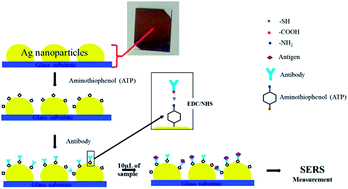Design and fabrication of random silver films as substrate for SERS based nano-stress sensing of proteins†
Abstract
We report a simple and easy to fabricate random silver film (RSF) as a highly sensitive Surface Enhanced Raman Scattering (SERS) substrate which can be fabricated directly onto a dielectric substrate such as glass. An electron beam evaporation system was used for substrate fabrication. The SERS activity is attributed to the formation of electromagnetic ‘hot-spots’ on the film. Substrate performance is analyzed by studying the reproducibility and signal enhancement from the Raman active molecule, 2-naphthalene thiol (NT), which is covalently anchored to the substrate. The metal thickness is optimized to achieve the highest SERS enhancement. Based on this study we found that a 7 nm RSF substrate gave the best SERS activity. The SERS signal intensity exhibited by 7 nm RSF is found to be at least 3 orders of magnitude higher than that of a commercial substrate. The SERS enhancement factor is estimated to be ∼1 × 107 with a point-to-point intensity variation of about 12% and it reaches a maximum of 15% for batch-to-batch comparison. The efficacy of this substrate for biosensing is demonstrated by detecting H1 influenza protein, and the detection limit is found to be ∼10 pM when it is used along with a recently established nano-stress SERS sensor, 4-ATP (4-amino-thiophenol), as linker molecule. This detection limit shows a performance superior to conventional ELISA (which has a nM detection limit). These results show promise for the development of a biosensing platform based on the marriage of RSF with nano-stress sensors.


 Please wait while we load your content...
Please wait while we load your content...